The Ultimate Vibrato Guide: 12 Easy Steps for Singers
As a voice teacher, I can tell you that vibrato is one singing technique that can make any singer sound world class.
Is vibrato necessary to be a good singer? Well, some may disagree, but for my part, I couldn’t live without it!
Seriously, is there anything better than a beautiful, soaring vibrato in a song?
Just look around and you’ll find tons of fantastic singers using voice vibrato to add richness and beauty to their singing.
But vibrato singing doesn’t just work wonders for the listener…
Learning how to sing vibrato naturally and confidently will also make you feel like a world-class singer.
And that’s something every singer wants.
Check out these vibrato singing examples. The list includes famous male and female vibrato singers:
Every day I help students learn to sing with vibrato. And, over the years, I’ve experimented with how to teach vibrato singing all kinds of different ways.
With that said, here are:
By the way, if you want a vocal program that will take you through all these singing techniques, you can check out my complete singing course, Master Your Voice, here.
It’s incredibly rewarding because after all the scales and vocal exercises, singing with vibrato makes them feel like a real singer.
But what exactly is vibrato singing?
If you’re new to vibrato singing for beginners, you might be wondering what is vibrato in singing and how to achieve this vibrato voice effect.
The vibrato singing definition is actually quite simple, and understanding the different types of vibrato singing can help you master this technique.
And how do you teach yourself to sing with vibrato?
Today, let’s talk about the vibrato singing voice and how we can use it to take your vocals to the next level.
What Is Vibrato?
What’s vibrato in singing? How do you know if you have vibrato in your singing?
Let’s look at a definition.
Vibrato Definition: Vibrato is a rapid, slight variation in the pitch you’re singing, marked by a rapid wavering in the intensity and timbre of the note being sung.
Here’s what it looks like on a spectogram.
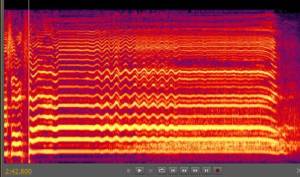
Okay, so that’s the definition of vibrato in music. But what does all that mean?
Chances are when you first heard vibrato voice, the first thing you noticed was that their singing sounded like it’s wavering.
But this variation in pitch is only one aspect of authentic vibrato.
There are 3 main components of vibrato: pitch, volume and timbre.
Pitch is the note that the vocalist is singing, volume is the strength or intensity of that note, and timbre is the tone or distinct sound of that note.
In addition to the pitch, you will also hear that the volume and fullness of the note also wobbles with vibrato singing.
This results in a fullness and richness in your singing that sounds very exciting.
For one of the best famous female vibrato singers, listen to Lady Gaga’s vibrato when singing:
As for famous male vibrato singers, Elton John is a fantastic example of vibrato singing to learn from:
You can also contrast vibrato with a straight tone.
With a straight tone, the pitch is sustained but it doesn’t vary.
Listen to BYU’s Men’s Chorus. When they hold a note, they sing a straight tone.
Vibrato in Voice Music
When should vibrato be used?
Turns out, singing with vibrato can be heard in most styles of music.
In fact, when you look at vibrato’s use in various musical genres, Pop, Rock, RnB, Opera and Musical Theater all use it.
That means learning to sing with vibrato is important for singers in almost every genre.
A common question among vocalists is: Is it better to sing with or without vibrato? While both techniques have their place, vibrato adds warmth and emotion to sustained notes and can help prevent vocal fatigue
The main exceptions are genres with an emphasis on blending voices together like choir, barbershop and a capella music.

That’s because it’s hard to blend and harmonize 15 wiggling voices at the same time.
But in almost every other genre, singers use vibrato to accent their best notes.
So if you’re planning on hitting a high note but don’t have vibrato yet, let’s fix that right now.
What Vibrato is Not
These days there is a lot of confusion about what vibrato really is.
So before we talk about true vibrato, let’s discuss what vibrato is definitely not.
Vibrato Does Not Come from Shaking or Moving Your Jaw
During the 80s and 90s, singers like Whitney Houston and Mariah Carey gave amazing performances using vibrato.
But in order to dramatize their high notes, these singers learned to move their jaws rapidly to make their vibrato more noticeable.
Unfortunately, this so-called “gospel jaw” bred a generation of singers that believed the key to singing vibrato was moving their jaw quickly.
The crazy thing is that these singers could sing with true vibrato.
They just sang with “gospel jaw” to make their performances more exciting for people.
But as we’ll see, vibrato doesn’t come from rapid jaw movement.
Vibrato is Not a Vocal Trill
In classical music, there is a very common vocal effect called a trill.
A trill happens when a vocalist sings between two adjacent notes very quickly.
Vocal trills look like this:

This makes the vocal trill easy to confuse with vibrato since they both seem to be wavering between two different notes.
However, true vibrato actually revolves around a single note whereas a vocal trill toggles between two notes.
Check out this example of vibrato singing to see what I mean:
The first notes she sings are a trill, then she begins singing with vibrato. This makes the differences between the trill effect and vibrato effect immediately clear.
These days, great singers like Ed Sheeran, Demo Lovato and Adele sing vocal trills that span multiple notes.
And even though they can transition between notes really quickly, these riffs are different from vibrato. That’s because these riffs span different notes, rather than wavering on a single note.
Vibrato Does Not Come from Pulsing the Diaphragm
Many singers try to create the sound of vibrato by pulling in and pushing out their abs to make rapid pulses of air.
While vibrato wavers in volume (remember vibrato is a slight variation in pitch, intensity and timbre), pulsing the diaphragm does not create true vibrato.
Still there are many singers that create a vibrato sound by pulsing their breath.
One of the best examples of songs with vibrato singing is this number by Aaron Neville:
Listen to the last word of each line he sings.
That’s diaphragmatic vibrato.
However, true vibrato does not come from pulsing the diaphragm.
Vibrato Does Not Come from Shaking the Larynx
What about the throat? Does vibrato come from the throat shaking?
Sorry, another common misconception.
One habit that many beginning singers try is shaking their larynx with their hand while they sing.
This technique is especially bad since it adds more tension to the throat.
Shaking the voice box will certainly create a vibrato-like sound, but it’s not a good way to find true vibrato.
Plus it looks kind of funny when you shake your larynx on stage.
Generally Speaking…
All these vibrato techniques have their place.
But some are worse than others.
Vibrato tends to come out best when the voice is relaxed but some of these techniques add tension to the voice.
This eliminates any vibrato you might have had to begin with.
So now we’re clear on what vibrato is not, let’s talk real vibrato.
What is real vibrato in singing?
How do you get vibrato in your voice? Well, here’s what all the fuss is about:
Modern research suggests that vibrato is caused by a muscular tremor in the vocal folds.
That’s it!
Some students ask me: is vibrato good for singers? Or is vibrato singing bad for the voice? They wonder if vibrato strains the vocal cords after too much usage.
Quite the contrary, in fact!
Scientists have shown that vibrato in singing is the result of the work-rest cycle of the muscles in your voice.
Think about when you lift something heavy.

Your muscles start to shake after a while, right?
That’s because as your muscles become fatigued, certain muscles switch on and off in order to rest.
Vibrato works the same way.
With vibrato, two muscle groups in your voice tense against each other.
As the muscles start to fatigue, they take turns switching on and off, creating the waver we hear as vibrato.
That means that singing with a straight tone is actually harder than vibrato since you’re fighting the body’s efforts to rest.

So not only does vibrato sound great, but once you find it, singing sustained notes gets easier!
Two last things…
The Speed of Vibrato
Studies have shown that vibrato oscillates at about 6 cycles per second.
If the note spins faster than that, the effect is known as tremolo.
If it’s too slow, it’s called a wobble. This is “wide vibrato singing”.
So it’s good to familiarize yourself with the right speed of vibrato.
Listen to some of the masters and get an idea for the perfect speed for your vibrato.
You can find countless examples of how to vibrato singing on YouTube.
Some of the best vibrato singers demonstrate different approaches – from the controlled vibrato of classical singers to the expressive vibrato singing female artists like Lady Gaga and Celine Dion use in pop music.
Can most people sing vibrato? The answer is yes – with proper training and practice, most singers can develop this skill.
Check out this video of Freddie Mercury improvising.
Note that every time he holds a note, he adds vibrato.
The Pitch of Vibrato
We now know that real vibrato centers around one note.
However many voice teachers still debate whether vibrato wavers below or above the pitch.
The answer is that vibrato oscillates both below and above the pitch you’re singing.
Studies show that the typical extent of vibrato is around one whole tone above and below the pitch. Although that changes according to the vocal style of the singer.
Check out this image of vibrato on a spectrogram.
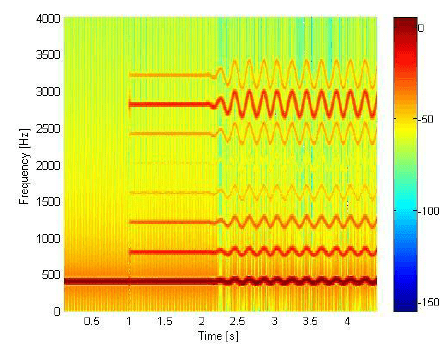
You can see the note sung on a straight tone followed by the vibrato.
You’ll see the vibrato naturally oscillates above and below the desired pitch.
But rather than hearing the note going flat and sharp, we just hear one beautiful pitch.
Now that we’ve talked about the cause, speed and pitch of vibrato, let’s show you how to actually sing it.
Is Vibrato Natural or Learned?
Let’s deal with a huge myth right now:
No one’s born with vibrato.
Like any other singing technique like belting or vocal fry, vibrato is something that comes the more you work at it.
So, if you clicked here wondering how to learn vibrato singing, the answer is simple: practice, practice, practice!
More specifically, vibrato comes out most when the voice is in balance. And learning to sing in balance takes time.
Singing with vocal balance means that the muscles in your voice are developed and can work evenly with each other.
Let me explain by going back to our weight lifting analogy.
If I haven’t built up my arm muscles enough, I won’t be able to lift the weight, let alone hold it.

But if bicep and my triceps are evenly strong, when I hold the weight, my arm will shake.
You can see this for yourself.
Try this:
- Extend your right arm to your right side in a straight line from your shoulders and make a fist.
- Tense the muscles in your arm like you’re flexing but keep the arm straight.
- Flex your arm in this position for 5 seconds.
You should feel that the muscles in your arm tremor and shake when they’re flexed this way.
That’s because the muscles are pushing and pulling against each other.
Is singing vibrato conscious or unconscious?
Is vibrato a conscious thing or an unconscious thing? Can you control your vibrato?
When starting out, it may take some conscious effort to learn to control your vibrato and sing vibrato at will.
But, after some practice, yo may find yourself unconsciously slipping vibrato into your normal singing routine!
I can tell you, it’s a magical feeling when that happens.
How long does it take to learn vibrato singing?
This is by far the number one question I get on the topic of vibrato:
How long does it take to develop vibrato?
This is a difficult question to answer and it depends a great deal on the student.
Why?
Well, most beginning singers are tend to be stronger in one of their vocal registers.
We call these registers the chest voice and the head voice.
You can read more about the differences between chest voice and head voice here.
But if you’re only strong in one vocal register, that’s like using just your bicep to lift a weight.
That muscle may be great for pulling, but it sucks at pushing.
The same is true in your voice.
For instance, if you sing breathy and light on the bottom of your voice, that’s because you’re more dominant in the muscles that control head voice.
Or if you yell and strain when singing higher notes, that means you’re dominant in the muscles that control chest voice.
Learning not to strain is very important if you want to expand on the range you have. If you’re not sure what your range is, you can find your vocal range in less than a minute!
Now if either one of these scenarios sound like something you’re working on, check out this article with 10 singing techniques to improve your voice.
Or if you’d like me to jump right in and start learning to master your voice, check out my online singing lessons here.
There are tons of exercises which will help you expand your vocal range and, by extension, your vibrato singing range.
An expanded vibrato singing range means you can hit high notes and sing stronger, all while adding that rich, buttery-smooth vibrato to your voice.
These exercises will also help you find the vocal balance necessary to sing with vibrato.
Don’t worry, I’ll wait right here while you check them out.
5 Vibrato Singing Tips
Let’s assume that your voice sounds pretty good but vibrato hasn’t shown up yet.
No worries!
Like any other singing technique, learning how to ace vibrato singing takes time.
There are lots of vibrato singing exercises to help you get the feeling of vibrato.
But before we get into the techniques for producing vibrato, we need to set ourselves up for success.
Here are the 5 prerequisites for finding good vibrato.
Posture
Before we start to sing with vibrato, we must have good posture.
I’ve written an article that deals with the correct posture for singing you can check out.
But for now, let’s break it down in the simplest terms.
When you’re singing vibrato, you want to have a tall posture.
That means:
1. You’re standing with your feet spaced evenly at shoulder width
2. Your hips should be above your feet
3. Keep your chest comfortably lifted
4. Your neck is relaxed evenly above your shoulders; not looking down or up.
Want to Nail Those High Notes?
Every singer wants to expand their range. Expand Your Range Fast will show you how to finally hit high notes in your voice without straining. Expand your range by 5 notes or more!
With this tall posture, you’re perfectly set up for the next vibrato prerequisite: breathing for singing.
Breath
Now that we’ve found a tall posture, we’re perfectly set up for the correct breath for singing vibrato.
The correct breath for vibrato is called a diaphragmatic breath.
I’ve written an article on how to get the perfect breath for singing.
But for right now, here’s what you need to know:
1. Stand in front of a mirror and turn to the side so that your right shoulder is perpendicular to the mirror.
2. Turn your head to the right so you can see your stomach in the mirror.
3. Place your hand on your stomach.
4. Without moving your chest or shoulders, inhale through your mouth and allow the breath to push your stomach out against your hand.
5. Now exhale and allow your stomach to come back in. Your hand should follow it in.
Now that we have found our perfect breath, let’s talk about a crucial element of vibrato: relaxation.
Relax Your Body and Voice
As we learn to sing vibrato, we want to make sure our body and voice are relaxed.
Now there’s kind of a golden medium here:
We want to make sure your voice is relaxed, but not too relaxed.
For instance, if you hear a lot of breath as you sing the following exercises, the vocal cords are too open and will not produce good vibrato.
Or if you hear tension in your voice the cords may be too pressed and will not produce good vibrato which leads us to number four.
Make Sure Your Voice is in Balance
Remember, most singers are dominant in either their chest voice or their head voice.
So if your voice is light and breathy on the bottom or strainy and shouty at the top, vibrato won’t show up.
Vibrato comes much more easily when your voice is balanced.
If this sounds like you, it’s time to go check out this article on techniques to Improve your voice.
I promise you, if you put in a little more work on getting the voice in balance, the vibrato will come more easily.
Which leads us to number five.
Be Patient
Finally, it’s incredibly important that you are patient when developing vibrato.
If it’s not coming, do not force it.

There’s a good chance you’ll find vibrato on these exercises, however you may not be able to hear it in your own voice yet.
Try recording yourself doing the following exercises and listen for the wavering in your voice.
If you hear vibrato, ask yourself what you were doing to accomplish this?
Take note of the feeling that you get when you sing this way.
Some people feel vibrato as a quivering of the pitch.
Others feel little bursts of air hitting the back of their throat.
There’s no right or wrong answer.
The only right way to learn vibrato is to find an exercise that works every time.
Then you can start to expand that feeling to the rest of your singing.
How to Sing Vibrato: 12 Easy Exercises
Diaphragmatic Vibrato Exercises
The first few exercises we’ll work on are not true vibrato.
But they will help you find the volume variations we hear in vibrato.
So when you’re doing them, just focus on the alterations of breath you feel.
Exercise #1: The Diaphragm Pulse
Earlier I mentioned that pulsing the diaphragm does not give you true vibrato.
But if you’re brand new to vibrato, sometimes it’s great to just get the feeling of the alternating breath required.
So let’s start with a diaphragm pulse.
Here’s how you do it:
- Make a fist with one hand
- Cover the fist with your other hand
- Keeping your hands in this position, place them an inch above your belly button.
- Take a diaphragmatic breath and sing and hold the vowel “ee” (like “eat”) on a comfortable pitch (try E3 for men and B3 for women)
- While you’re singing the pitch, push your hands on your abs in and out rapidly like you’re giving yourself CPR.
- Try to get the hands to pulse about 6 cycles a second.
You should hear a pulse in the breath as you sing the vowel “ee”.
The voice may sound like you’re trying to turn a car on but it won’t start.
That’s exactly right.
Don’t know where to start with this exercise?
I just created a video to demonstrate this exercise. Check it out:
Exercise #2: The Beggar’s Pulse
Physically pushing into your diaphragm isn’t the only way to get the wavering breath required for vibrato.
The Beggar’s Pulse is another way of alternating your breath without having to touch your stomach.
Here’s how you do it:
- Bring your hands together in front of you and interlace your fingers like you’re begging for something
- Take a breath and sing the vowel “ee” on a comfortable pitch (E3 for men and B3 for women)
- While you’re singing the pitch, shake your interlocked hands in front of your body.
- Do this rapidly at about 6 cycles a second.
While singing the “ee” vowel, you should hear a strong pulse wavering on the pitch.
If you’re not sure how to do vibrato singing in this exercise, don’t worry.
Here’s a section of my How to Sing Vibrato video that demonstrates the exercise:
Pitch Vibrato Exercises
Now that we’ve found the breath variations in vibrato, let’s waver to pitch.
These exercises will help you find the variation in pitch we hear with vibrato. And these vibrato singing tips will help you learn to get that beautiful shimmer in your voice.
Ideally the alternating breath will come with it, but it’s not required.
Remember, don’t force it.
Just be patient and the vibrato will show up.
Exercise #3: The “Jaws” Theme Vibrato
Do you remember the music from the movie “Jaws”?
The theme music has a melody that goes from the first note up a minor second interval (just a half step on a keyboard). Then the melody that gets faster and faster.
Let’s use this melody as a vibrato singing exercise to stimulate that wavering.
Here’s how:
- Take a diaphragmatic breath and hum an “mm” sound (like you just had something delicious) on a comfortable pitch (E3 for men and B3 for women)
- Now, start to hum up a half step to the second note (F3 for men and C4 for women). It should sound like the melody from jaws
- Toggle back and forth between your starting note and the second note as fast as you can
- Once you’re singing this melody very quickly, try to “let go” of singing the interval and see if you can get the first note to waver.
If you don’t hear vibrato right away, don’t worry.
Just work on getting a steady pulse going.
As you continue to practice, see if you can get the same wavering feeling on the first note.
If you don’t have a piano handy, don’t worry.
Here’s a section of my How to Sing Vibrato video that demonstrates the exercise:
Exercise #4: Prime the Pump
Remember that vibrato is a slight variation below and above the pitch you’re singing.
In the last exercise, we worked on finding the vibrato by singing up to a minor second and coming back.
Do you know the song “She Will Be Loved” by Maroon 5?
This is one of the best vibrato songs because the chorus involves a descending minor second interval that goes from an Eb4 to D4 when he sings “I don’t mind spending ever-y day”
This time, let’s use this melody to prime the vibrato by singing our target note and then dipping slightly below it.
Here’s how you do it:
- Take a breath and hum an “mm” sound on a comfortable pitch (try G3 for men and D4 for women)
- Now, start to hum down a half step to the second note (F#3 for men and C#4 for women). It should sound like the melody from the chorus in “She Will Be Loved”
- Toggle back and forth between your starting note and the second note as fast as you can
- Once you are singing these two pitches very quickly, try to “let go” of singing the interval and see if you can get the first note to waver.
Again, if you don’t hear the vibrato kick in, don’t worry about it.
Just try to get the interval moving as quick as you can and pretty soon that note will quiver all on its own.
If you don’t have a piano handy, don’t worry.
Here’s a section of my How to Sing Vibrato video that demonstrates the exercise:
Exercise #5: The Happy Birthday Vibrato
Some folks need a larger interval than a minor second to kick-start their vibrato.
In this exercise, we’ll use a major second interval to get the vibrato spinning.
The major second interval is the same one you hear at the beginning of the “Happy Birthday” song.
Listen to the first three notes:
“Happy birth-day”
That’s a major second.
Let’s use this interval to get our vibrato spinning.
Here’s how to do it:
- Take a breath and sing an “ee” vowel on a comfortable pitch (try E3 for men and G3 for women)
- Now, start to move up a whole step to the second note (F#3 for men and A3 for women). It should sound like the first notes of “Happy Birthday”.
- Toggle back and forth between your starting note and the second note as fast as you can on “ee”.
- Once you are singing these two pitches very quickly, try to “let go” of singing the interval and see if you can get the note to waver.
- If you have trouble finding the vibrato on the “ee” vowel, try an “ooh” instead.
If you don’t have a piano handy, don’t worry.
Here’s a section of my How to Sing Vibrato video that demonstrates the exercise:
This exercise is great for singers who have a bit of tension in their voice.
Ultimately we don’t want our vibrato to be larger than a half step.
But when you’re first starting to find the feeling of vibrato, let the pitch wobble as widely as you like.
Then as the vibrato comes easier, try to keep the variation to a half step.
Exercise #6: The Ghost Vibrato
Up until now, we’ve been experimenting with pitch variations that are mostly in the low part of your voice.
Now, it’s time to try some vibrato a little higher in your range.
But before I give you any exact pitches to sing in your upper register, let’s loosen things up with the Ghost Vibrato.
Here’s how you do it:
- Take a breath and make an “ooh” sound like a ghost trying to scare someone in a haunted house.
- Really let that “ooh” sound shaky and scary.
- Now sing the ghostly “ooh” sound on a comfortable note in your head voice or falsetto (maybe A4 for men and E5 for women).
- Now slowly let the “ooh” shake and fall from the high note to the bottom of your voice. It should sound like the combination of a ghost and a police siren.
While the ghost vibrato doesn’t cover any exact pitches, it’s great at helping you find vibrato in your higher register.
So let’s take a look at some exercises that do both.
Vibrato Exercises for Higher Notes
Who are we kidding?
What’s the point of being able to sing vibrato if you can’t sing it on high notes.
Let’s work on some exercises that will help you find the spin we’re looking for on the best notes in your range.
As a reminder, if you’re still breaking or straining on the higher notes in your range, vibrato will be harder to find.
It’s better to go back a step and work on some Singing Techniques to Improve Your Voice.
However, if you can sing smoothly from the bottom to the top of your range without cracking or straining, let’s make them sound richer and fuller with vibrato.
With the following exercises, feel free to incorporate elements from the diaphragmatic and pitch vibrato sections.
For example, if you were able to find a beautiful vibrato with the diaphragmatic pulse exercise, feel free to practice these exercises with your hand pulsing the top note.
Or, if the “Prime the Pump Vibrato” exercise worked wonders for you, try singing the highest notes in these exercises and then toggle back and forth with a minor second interval.
The point is, use what works for you.
Now, are you ready to belt those high notes with a beautiful vibrato?
Let’s get started.
Exercise #7: The Silent “H” Vibrato
We know that vibrato has a variation in breath and pitch, so let’s guide the vibrato where we want it.
Here’s how to do it.
- Take a diaphragmatic breath and sing an ascending 5-Tone scale on the word “Hee” (like “he’s singing.”) using a comfortable starting pitch (Try D3 for guys and A3 for girls)
- When you get to the fifth note in the scale, sustain the note imagining that you’re singing several “He”s on the top note
- But rather than repeating the word “He” on the top note, imagine that you are erasing the “H” consonants with every repetition.
This should create a beautiful natural spinning vibrato on an “ee” vowel up there.
If you need help, try actually repeating the word “he” up there.
Then take the repeat away and see if you can make the “ee” spin.
If you don’t have a piano handy, don’t worry.
Here’s a section of my How to Sing Vibrato video that demonstrates the exercise:
Exercise #8: The Fee Vibrato
An “H” consonant isn’t the only way to pulse the breath necessary to creating a spinning vibrato.
An “F” consonant can do the trick too. It also may be better for those singers who are having a hard time singing stronger at the bottom of their voice.
Here’s how you do it:
- Take a diaphragmatic breath and sing an ascending 5-Tone scale on the word “Fee” (like “fever”) using a comfortable starting pitch (Try D3 for guys and A3 for girls)
- Sustain the top note of the scale with a clear emphasis on the “F” consonant
- Rather than tightening or clenching on the top note, allow it to go wherever it wants—the wobblier the better.
You should hear a clean, ringing vibrato on the high “Fee” note.
Now let’s get to some really high notes.
But before we do, if you’re having any difficulty singing with vibrato at the bottom of your voice, work on the exercises in the previous section until you find it.
Exercise #9: The Shush Vibrato
Have you ever shushed someone that was being too loud?
Did you notice how much air leaves your mouth as you make the “sh” sound?
Let’s use that sound to our advantage with the “Shush Vibrato” exercise.
Here’s how to do it:
- Take a diaphragmatic breath and sing an ascending octave scale on the word “She” (like “she’s singing well”) using a comfortable starting pitch (Try F#3 for guys and C#4 for girls)
- Repeat the top note four times and then sustain the fourth repetition.
- When you sustain the fourth note, allow yourself to “let go” of the sustained note and let it spin.
With any luck you will hear that the vibrato spins beautifully on this high note in your range.
If you don’t have a piano handy, don’t worry.
Here’s a section of my How to Sing Vibrato video that demonstrates the exercise:
Exercise #10: The High Hee Vibrato
Using the “sh” consonant isn’t the only way to get vibrato spinning on those high notes.
An “H” consonant can also help.
Here’s how you do it:
- Take a breath and sing an ascending octave scale on the word “He” (like “he’s singing well”) using a comfortable starting pitch (Try F#3 for guys and C#4 for girls)
- Repeat the top note four times and then sustain the fourth repetition.
- When you sustain the last note, try to “let go” of the note and let it spin.
Unlike the “Shush” vibrato in the last exercise, there’s not a lot to hold only for the high note in this exercise.
So this may be perfect for those singers that tend to yell as they sing higher.
Exercise #11: The High Fee Vibrato
This is essentially the same exercise as the “High Hee Vibrato” covered in the last exercise.
However, if you find yourself getting winded trying to sing the “Hee” in the last exercise, this should do the trick.
Here’s how you do it:
- Take a breath and sing an ascending octave scale on the word “Fee” (like “fever”) on a comfortable starting pitch (Try F#3 for guys and C#4 for girls)
- Repeat the top note four times and then sustain the fourth repetition.
- When you sustain the fourth note, let go of the note and let it spin.
You should hear a clean spinning vibrato on the top note.
Exercise #12: The Foo Vibrato
The “ee” vowel we used in the previous exercises may not work for those singers that tend to yell or strain on higher notes in their range.
Don’t worry, we’ve got just the fix for you.
The “ooh” vowel can help loosen things up.
So let’s give it a try.
Here’s how you do it:
- Take a breath and sing an ascending octave scale on the word “Foo” (like “food”) using a comfortable starting pitch (Try F#3 for guys and C#4 for girls)
- Repeat the top note four times and then sustain the fourth repetition.
- When you sustain the fourth note, “let go” of the sustained note and let it spin.
You should hear a clean, ringing vibrato on that high note.
If you don’t have a piano handy, don’t worry.
Here’s a section of my How to Sing Vibrato video that demonstrates the exercise:
Congratulations
At this point, you’ve tried many of the best exercises to sing vibrato.
In conclusion: does everyone have vibrato? Yes! Everyone who puts in the time and effort can learn to sing vibrato.
To that end, I truly hope some of the exercises have worked wonders for you and helped you learn vibrato singing.
But if they didn’t, stay patient and the vibrato will come.
Also, remember you may not “hear” the vibrato in your voice clearly yet.
Sometimes the wavering of vibrato can start out very small and grow larger.
Try recording yourself singing these exercises and listen back.
Ask yourself what worked best and try to repeat the process.
Now I want to hear from you!
Leave a comment below and let me know which vibrato singing technique worked best for you and any questions you have.
I respond to every message.
And don’t forget:
If you have any questions or want more pointers on finding vibrato, feel free to book your first lesson at the Ramsey Voice Studio.
Want to Nail Those High Notes?
Every singer wants to expand their range. Expand Your Range Fast will show you how to finally hit high notes in your voice without straining. Expand your range by 5 notes or more!










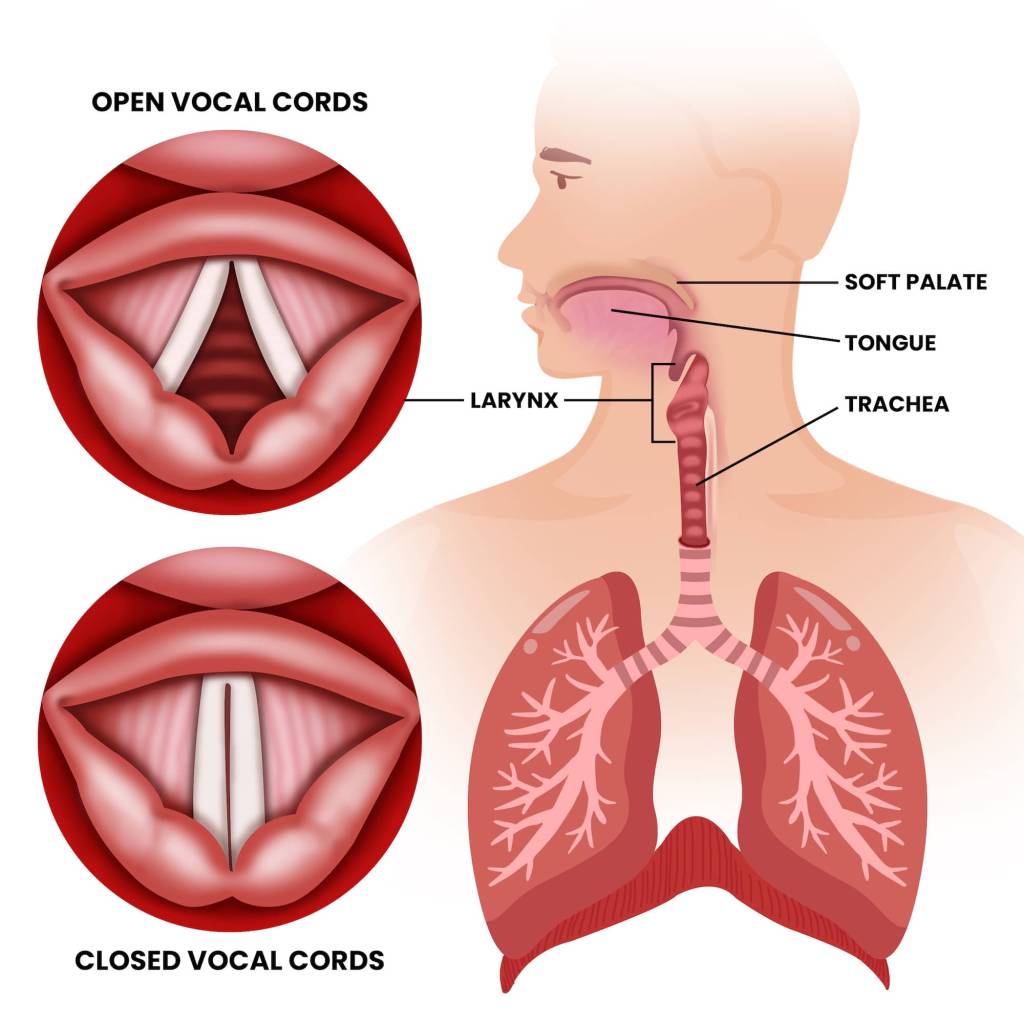
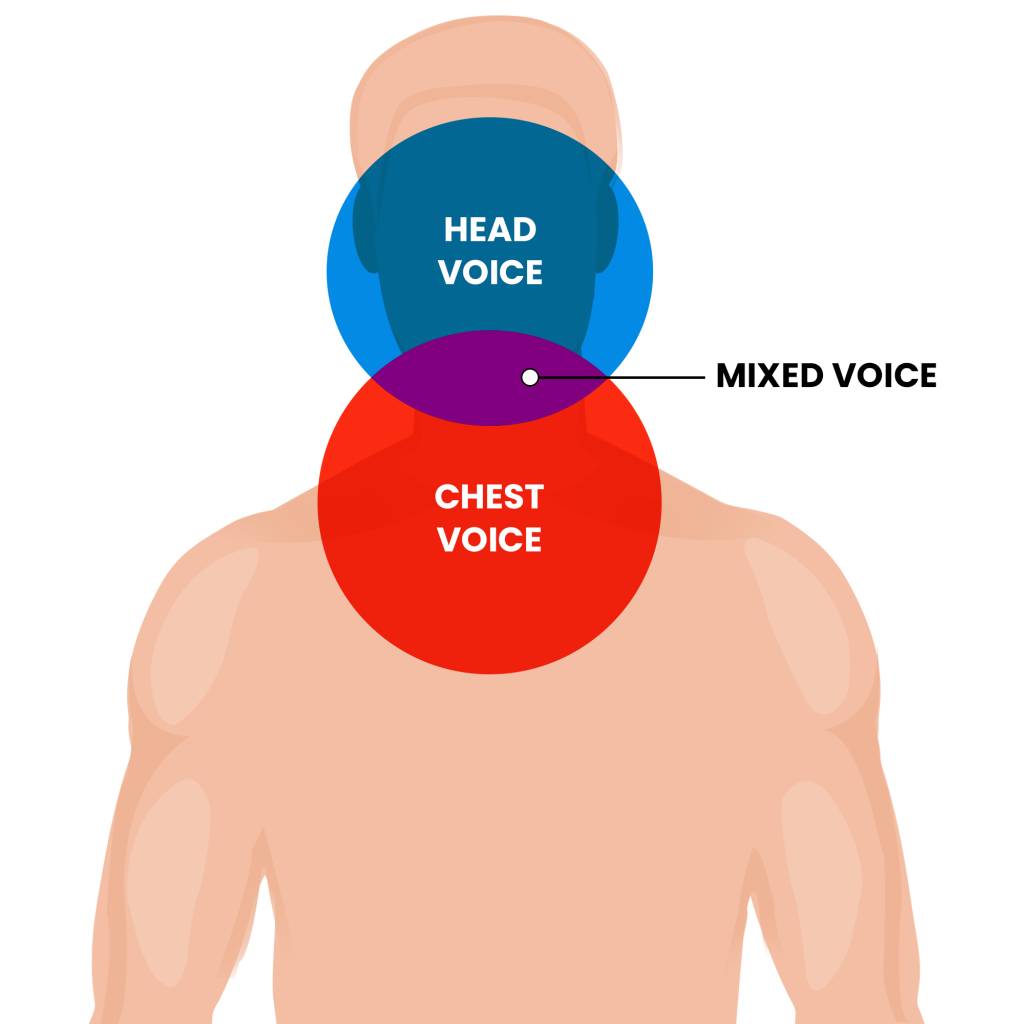
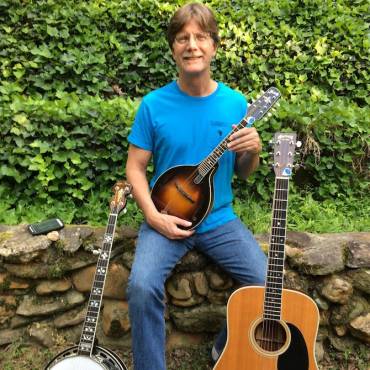

36 Comments
“Nobody is born with Vibrato?” lol NONSENSE, myself, mother and grandmother all sing with a natural vibrato, it was never taught, but a natural given talent. i was singing with a natural vibrato at 5.
Hey Michelle,
Thanks for your comment. I think that it’s possible that BECAUSE your mother and grandmother always sang with vibrato, that you learned it by imitating them. These kinds of cues in childhood are incredibly powerful. Imitation is a huge key in learning to sing better. -Matt
Yes i would have agree, you may not be born with vibrato but some do have a natural ability.
Because when they first learn to sing they pickup the whole sound and make the notes and the vibrato. Like birds copy sounds. And some are amazing who can fine control its speed and width ( my layman’s terms ) during a phrase or note, I love how they can introduce the vibrato slowly and kind of fiddle with it and back off. Knowing just how to give it their unique signature ( like patsy cline ).
Ah! What a gift it is to be able to sing! And it’s really such a shame that so many who understand the detail and love music so much and who long to sing will never come close. It’s like the ugly looking person who longs for a girlfriend for his whole life but never even gets a kiss! Such is for us who hears the song sung but in a group of friends must keep our mouths shut or else ruin the the beauty of the moment.
I think we all would love to sing well and would pay a high price for any improvement, we may try to all our lives and still never sound good enough to escape getting hit with a shoe! Some who I guess are tone deaf don’t know how bad they sing. ( maybe their ignorance is something to be envied ) but in all honesty its more like bad breath, your friends wont tell you. And its even less likely they’ll Tell you your voice is horrible, they just won’t because to be told you are either one of those things would DEVASTATE most normal people.
Hearing ones own VIBRATO on a recording I found to be the opposite for me. What little VIBRATO I thought I produced wasn’t noticeable at all when played back on a recording.
We all are born with different anatomies or vocal chords. Some poor souls are born with a raspy frog sound. My greatest shortfall has always been not being able widen my range beyond three to four notes. Not without straining. And as I age theres a constant flip that I can clear. ( No doubt thats because of diet )
So for my part it’s very discouraging to hope you might be able sing a bit better but for REALISTICALLY some of us must modestly recognize we never will enjoy singing unless its alone in secret. Yes secret, what is more humiliating than getting caught trying to sing? ( Only us who cant sing really know )
But I am very confident that for a great many who discover your website will have the opportunity to improve by leaps and bounds. Because the instructions you offer are very essential and will reach ones who’d never get any help otherwise.
Some may have had a few lessons while growing up for a musical instrument. But how many have ever had even one voice lesson? No one I have known. Only those who were discovered and seen as IMMENSELY talented.
Thank you for your free lessons on developing VIBRATO I will try it because I am HOPELESSLY in love with the FANTASY to sing my heart out and do it well!
Hey Hubert, thank you for your awesome message! You wrote very eloquently.
You mentioned that many singers won’t enjoy singing unless they do it in secret.
But I think that why it’s so important to take lessons.
You can’t expect to just walk in to the gym and lift 300 lbs, or play a sport at a pro level if you’ve never practiced.
The whole point of lessons is to work with someone who can help you learn to sing better so that you can enjoy it better.
Hope that makes sense!
I have been practicing singing since a month & have recently discovered the technique that produces vibrato like DEMi lovato does in her songs like ‘stone cold’, ‘give your heart a break’ etc. My pitch monitor app shows the exact vibrations i produce as those of demi’s. And this happens when I try to partially close the vocal cords while keeping breath steady. Am i confusing a trill with a vibrato here?
Hey Anita, thanks for your question. So awesome that you’re working on your vibrato.
A trill will be wider than true vibrato.
Specifically, you want to make sure that the pitch isn’t varying by more than a semitone.
That would be too wide and considered a wobble, rather than vibrato.
Hi, matt!
In this lesson, You mentioned that vibrato goes above the pitch and below the pitch. How can one get the pitch to go up and down without wobbling or tremolos? And, I noticed that some singers have fast vibrato. Is this right?
Thank you.
Hey Joy, the vibrato going above and below the pitch is the result of the vibrato in the voice, not the cause.
If you “make” the tone wobble, you’re looking at a tremolo.
Instead, try using the “diaphragm” pulse in the article to get the right pulsation in your voice.
Then, use the following exercises to get it without having to push in your stomach.
Thank you! I will try the exercises again!
How does one keep their voice box from moving when singing? Mine often goes up when I sing a scale. My singing book mentioned this, I thought you might have an exercise to help.
Thanks.
Hey Joy, yes it’s important that the voice box doesn’t move too much when you’re singing from low to high.
However, this is not the MOST important thing as you’re learning to sing.
More important is to start to sing evenly from the bottom to the top without breaking or straining.
If the larynx is the main culprit in not letting you do that, THEN we can look at what the larynx is doing.
But I would say that most of my students benefit from working on the muscles inside the larynx before controlling what the outside is doing.
I do give some exercises to prevent throat tension here:
https://ramseyvoice.com/how-to-sing/
“Before we get to vibrato let me drone on for 20 paragraphs, beginning each one with the phrase ‘before we get to what you want to Read about…’” Does this mean i’d have to pay for 20 lessons before you teach me anything? Sheesh.
Haha RU, I’m sorry you didn’t find my droning enjoyable. The honest truth is that for the longest time, voice teachers had NO idea what caused vibrato.
And for as big of a subject as vibrato is, there is room for a lot of different opinions about what vibrato IS and ISN’T.
Feel free to check out this video that cuts right to the chase: https://youtu.be/RFzsXVMcJoA
Hi, TYSM for good information but I don’t understand so much because honestly I’m only a bathroom singer that looooves to sing. I sing karaoke with others on a karaoke app. Now I would be thankful if you could maybe know if I can get a better voice because it’s awful, honest! I have no vibrato and I sound like a from, it’s raspy and if I try to sing HIGHER i get more raspy!! I have a low or deep raspy awful voice!
Hey Anne, thanks so much for your message!
Yes, I totally understand that you want to improve the raspiness in your vocal tone.
Often times that raspy or breathiness happens when the vocal cords are not closing effectively.
Try the 5-Tone Count and 5-Tone Mum exercises in this article and let me know how they work:
https://ramseyvoice.com/vocal-tone/
I’ve been singing for a while now (2 years) and I’ve gotten a lot BEtter, but I still don’t have vibrato. I think a large part of it is I am often not able to relax or sing at a full, unrestrained volume as I don’t want my apartment neighbors to hear me practicing. Any advice for overcoming this, be it PSYCHOLOGICAL or environmental changes? Thanks! (Sorry for the all caps, don’t know why it’s typing that way)
Hey Lauren, great question. I’ve found that there are lots of beginning singers that still need help finding vibrato.
So just in case you’ve read that you SHOULD have vibrato already, don’t worry.
I would recommend actually letting the voice wobble a little bit (such as the “Happy Birthday Vibrato) that I mention in the article.
Letting your voice “wobble” at first is preferable to sustaining a note with no vibrato.
Then, see if you can start to get the “wobble” to speed up a bit faster and tighter as it develops into a true vibrato.
I’m a drummer, and have only recently started teaching myself to sing. my focus is on pop. To me, most pop relies on a two bar, repeating groove, that makes use of rhythm, dynamics and pitch. and each instrument will hang on the groove, meaning that at any point in the song, whatever instrument is playing, including vocals, will usually have some of its parameters match the groove. I mention this because i’ve found that vibrato (or at least what i’m calling vibrato) is what pop lead vocals will use to match the rhythm and dynamics of the song’s groove. check out Ed Sheeran’s “perfect”; i think it’s a 12/8 song (4 sets of triplets per bar), and if you want to sing the song like he does, then you need to feel that 12/8-based groove going on, because that’s what he’s basing the wavering in his voice on. I’m interested in hearing your thoughts on this. thanks! (if this comes through in all caps, i apologize; i couldn’t turn it off).
Hey Jordan, great comment! Yes, I think that a rhythmic approach to vibrato and especially riffs and runs can be very helpful for beginners.
I love that you feel it in subdivisions.
I do believe that once you find a natural tremulousness in your voice (around 6 cycles per second), the vibrato will probably sound like it syncs up with any music that you sing.
Wow…thanks so much about all your supports and teach …I was singer , I sang in little for a five years ,but until still now, I can not get vibrato with on my talent…But I am really ,I will get it! I following all your information..
Awesome Biruk! So glad that you found it helpful!
Wow,so useful
Thanks Ramsey!
You’re very welcome Israel!
Very Nice, but the best vibrato in the world belongs to the best singer in the world — Dimash kudaibergen!
Hey Dan, I agree that Dimash has spectacular vibrato.
I have a wide range, C2-G6, and have some vibrato already. I will most definitely use these tips to work on making it even better. I do have a weakness. I suppose every singer, at every level does. While I can hit every note featured in the video about celebrities, In the higher notes, above say, G4, I can’t hold the note for as long, as I would like. I’m also hoping your tips about vibrato will make it come out more smoothly, especially on the grittier notes, some of my songs require.
Yes Gary! Keep up the good work. It will happen in time.
I have been SUCCESSFULLY using my vibrato for a couple of years. and about a MONTH ago i started to practice the song breathe from “in the heights” and my vibrato gets SEPARATED and SHAKY when i sing “Im coming back home” what can I do?
Hey Anna, I would try it on an exercise like “Nae” or “Mum” first and then try to add the vibrato to those exercises.
The late great John denver had, in my opinion, One of the smoothest and most natuRal vibratos i have ever heard. Virtually every note he saNg, from the start of a nOte to the finish, had vibrato. It seemed totally effortless. Do you truly think he learned to sing like that? It just seems way too natural to be learned. I would love to be able to sing half as good as he did. Thanks.
Hey Mike, great question! In my experience, vibrato is learned one of two ways: deliberately or through imitation.
Once a singer has found vibrato though, it’s a very natural part of singing and can absolutely be trained.
I disagree, I think Linda Rondstadt has the best vibrato.
Ronsdstadt has great vibrato!
NO RESULT AT ALL FOR ME, UNFORTUNATELY. I ALWAYS DID THE VIBRATO FROM MY DIAPHRAGM AND NOW I FEEL IT’S WRONG, NONE OF THE LAST EXERCIZE WORKED, I DON’T KNOW WHAT YOU MEAN BY LET GO OF THE NOTE. IT JUST DOESN’T WORK…
Hey Gabrielle, it’s fine to start by pulsing the diaphragm, but we don’t want to stay there forever.
If you can, feel free to take a first voice lesson so I can help you directly: https://ramseyvoice.com/book-singing-lessons/
I feel like the idea that elton John has a fantastic vibrato is MISLEADING. I LISTENED to that entire video and heard no vibrato at all. I’m GUESSING someone’s just a big fan and wanted an excuse to add a song oF his lol. Freddy mercury would have Been a good male EXAMPLE.
Hey Sacha, both Elton John and Freddie Mercury have great vibrato. No favorites here!